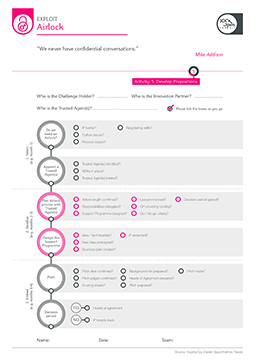Airlock
“We never have confidential conversations.”Mike Addison, Procter and Gamble


The Airlock is a process that allows partners to collaborate safely without fear of intellectual property contamination or fear of giving away an idea for free.
An Innovation Airlock is operated by one or two Trusted Agents. A Trusted Agent is appointed to act on behalf of both the Challenge Holder and the Innovation Partner. Alternatively a Trusted Agent can act for each party.
The Challenge Holder’s Trusted Agent needs to be intimately familiar with their client’s current innovation strategy and programmes. They will usually have a non-disclosure agreement (NDA) in place.
Trusted Agents for the Innovation Partner need to be both domain experts and experienced in working collaboratively. These parties will often sign a non-disclosure agreement too.
The Trusted Agent’s role is to encourage and facilitate communications between the two organisations by providing:
– Insulation for confidential information in both directions – entering into NDAs, receiving confidential information without communicating anything to the other party that is inappropriate or too early
– Coaching – helping both Challenge Holders and Innovation Partners to compellingly represent their needs and offers to each other in a common language
– Simplicity – Reducing the administrative and logistical challenges of the many separate dialogues with other Innovation Partners
– Process facilitation – leading the dialogues through a defined series of steps over a specific time period towards their intended conclusion
The Airlock is a temporary arrangement, and the goal is for the Trusted Agent to withdraw from the relationship as soon as a heads of agreement or other contract is agreed between the Challenge Holder and Innovation Partner. We recommend a time limit of 90 days (and preferably less) for the Challenge Holder to accept or reject a proposal and provide feedback. During this period the Innovation Partner agrees not to approach other potential buyers. If unsuccessful the IP reverts back to the Innovation Partner who is free to approach other buyers.

There are three phases: Select, Develop, Embed.
1.1 Do we need an Airlock?
Decide whether we definitely need an Airlock to effectively engage Innovation Partners. If the answers to the following questions are ‘yes’ then an Airlock will help.
1.2 Appoint a Trusted Agent(s)
Who are they, what are their qualifications and how much are they going to be paid and on what basis (retainer, consultancy fees, success fees, profit share, equity)?
1.3 Are appropriate Non-Disclosure Agreements (NDAs) in place?
It is usual for the Trusted Agents to sign an NDA with their client – either the Challenge Holder, the Innovation Partner or both as appropriate. Take legal advice about the specific NDA terms if unsure. Sometimes a standard NDA won’t allow enough freedom to communicate, especially if one Trusted Agent is representing both parties.
1.4 Have we briefed our Trusted Agent(s) comprehensively?
Do our Trusted Agents understand our innovation needs well enough (including technical factors) to effectively represent them to our intended collaboration partners? Do the Trusted Agents understand our concerns (about IP or otherwise) well enough to competently respect and manage them during the process? Have we clearly defined what can and cannot be shared?
2.1 Plan the Airlock process with our Trusted Agent
• How long will the Airlock process last?
• Who will be responsible for which aspects of the process?
• Will development workshops be used?
• What development support or coaching will be provided?
• Do we need to invite IP lawyers into the process?
• Is the Challenge Holder providing any development funding?
• What will be the ultimate go/no-go decision criteria?
• Have we agreed the Challenge Holder’s time limit for a decision?
2.2 Design the support programme
The Trusted Agents for the Innovation Partners provide coaching and support, convening regular calls, meetings and workshops throughout the Airlock period. The aim is to help build ideas into investment-ready business propositions in some or all of the following ways:
• Clarifying and checking the feasibility of the Innovation Partner’s technology or idea
• Prototyping new products or services
• Creating a business plan
• Protecting intellectual property
As well as coaching and support, the Innovation Partner will sometimes receive direct development funding to reward being selected for the Airlock and to incentivise the effort made to develop their propositions.
3. Embed (e.g. Months 4-6)
3.1 Pitch preparation
Has the Innovation Partner constructed the best pitch it can? It is important to construct a compelling pitch in the Challenge Holder’s language so that there is clear value for the client wrapped up in a realistic collaborative business model. The Innovation Partner rehearses and polishes the presentation.
3.2 Final Pitch
What date is the final pitch and who are the judges? Has the Trusted Agent prepared scoring sheets and other background information for the judging panel?
3.3 Heads of Agreement
Have we considered what contractual outcome we are looking for? The final objective of the Airlock is to produce a ‘heads of agreement’ (or other legal document that signals the intent to continue the relationship) between the Innovation Partner and the Challenge Holder. This should include a plan for further development and commercialisation plus an agreed business plan and IP strategy.
Source: Inspired by Daniel Oppenheimer, Nesta
You must be logged in to download this tool
You must be logged in to download this worked example
2014 - 100%OPEN LTD